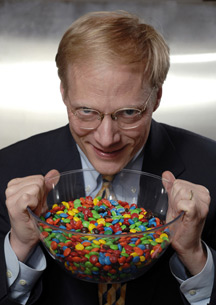Mood-food connection: We eat more and less-healthy comfort foods when we feel down, study finds
By Susan S. Lang

People feeling sad tend to eat more of less-healthy comfort foods than when they feel happy, finds a new study co-authored by a Cornell food marketing expert. However, when nutritional information is available, those same sad people curb their hedonistic consumption. But happier people don't.
In the January issue of the Journal of Marketing, Brian Wansink, the John S. Dyson Professor of Marketing, Applied Economics and Management at Cornell, and two colleagues describe several studies they devised to test the link between mood and food. For example, they recruited 38 administrative assistants to watch either an upbeat, funny movie ("Sweet Home Alabama") or a sad, depressing one ("Love Story"). Throughout the viewings the participants were offered hot buttered, salty popcorn and seedless grapes.
"After the movies were over and the tears were wiped away, those who had watched 'Love Story' had eaten 36 percent more popcorn than those who had watched the upbeat 'Sweet Home Alabama,'" said Wansink, author of the recent book "Mindless Eating: Why We Eat More Than We Think" (Bantam Books). "Those watching 'Sweet Home Alabama' ate popcorn and popped grapes, but they spent much more time popping grapes as they laughed through the movie than they did eating popcorn."
Wansink suspects that happy people want to maintain or extend their moods in the short term, but consider the long term and so turn to comfort food with more nutritional value. People feeling sad or depressed, however, just want to "jolt themselves out of the dumps" with a quick indulgent snack that tastes good and gives them an immediate "bump of euphoria."
To see whether nutritional information influences comfort-food consumption, the researchers offered popcorn to volunteers who completed several assignments, including irrelevant mental tasks, writing descriptions of four things that made them happy (or sad) and reading short stories that were either happy or sad. One group reviewed nutritional information about popcorn, while the other did not.
The researchers found that the sad people with no nutritional information ate twice as much popcorn as those feeling happy. In the groups that reviewed nutritional labels, however, the happy people ate about the same amount, but the sad people dramatically curbed their consumption, eating even less popcorn than the happy people.
"Thus, it appears that happy people are already avoiding consumption, and the presence of nutritional information does not drive their consumption any lower," said Wansink.
"While each of us may look for a comfort food when we are either sad or happy, we are likely to eat more of it when we are sad," Wansink concluded. "Since nutritional information appears to influence how much people eat when they are in sad moods, those eating in a sad mood would serve themselves well by checking the nutritional information of the comfort foods they choose to indulge themselves with."
The studies were conducted with Nitika Garg of the University of Mississippi and J. Jeffrey Inman of the University of Pittsburgh.
Media Contact
Get Cornell news delivered right to your inbox.
Subscribe